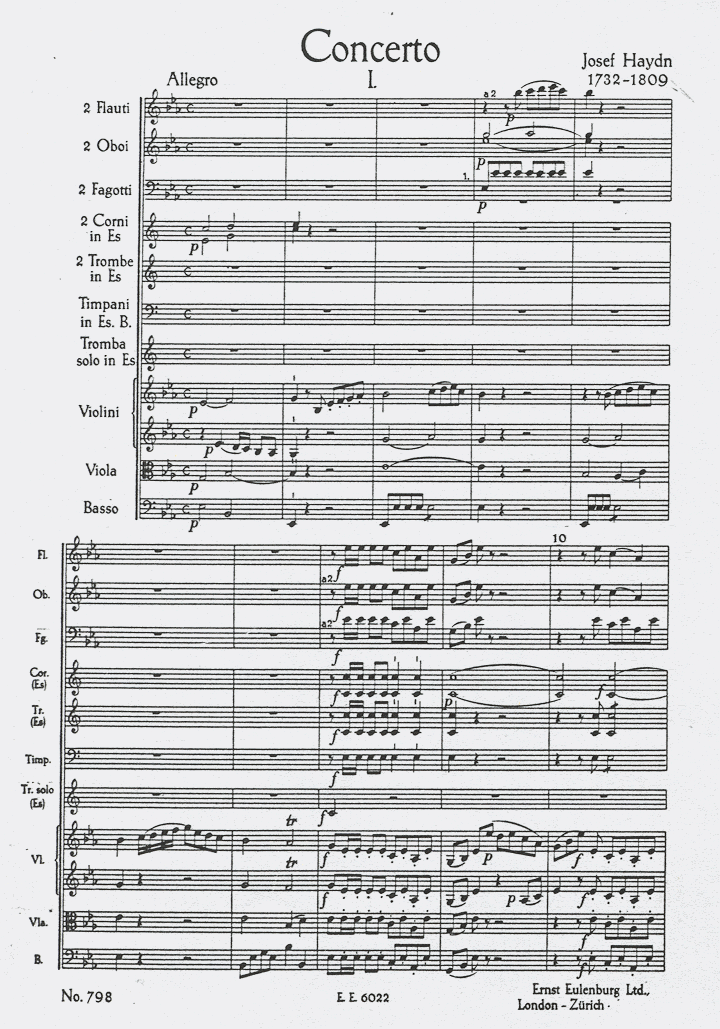


Texture / Timbre



In the 1750’s Haydn felt that homophony and polyphony were irreconcilable within the same movement, a notion suggested by some of his earlier quartets. However, he strove for a reconciliation of the 2 styles in his later compositions, in which rich contrapuntal lines enliven the essentially homophonic texture.
All 3 movements are homophonic in texture (i.e. a single melody by the trumpet is heard against a chordal accompaniment). In the accompaniment basically the same rhythm moves in all the parts.
The Arutiunian is basically homophonic in texture as well, but it does have intermissions of counterpoint too. Such as at E where the cellos and horns duet with the trumpet that plays a countermelody. At this point the two strands of melody run parallel, each on its own plane, seemingly unrelated and independent. This results in a couple of diminished intervals. It is fairly hard to listen too because each separate line interweaves with each other.
In the Haydn orchestra the separate groups of instruments were held in balance, and overemphasis of a single instrument was generally avoided. The orchestra depended on the sound image of the string tone for its main tone colour. The woodwinds, although occasionally used brilliantly, occupied a secondary role. The number of instruments used was not large. On the whole, transparency and clarity prevailed as Haydn strives to keep melody, rhythm, and harmony in proportion. Haydn includes all the ‘standard’ instruments in this concerto (see appendix no.3). However, he does not include clarinets and the wind and brass are used more sparingly in the slow movement. The latter can be said for the Arutiunian too.
Another textural factor is the size of the performing group: the Haydn concerto sounds light and transparent when performed by a small orchestra and the Arutiunian sounds heavy-textured when played with its full complement of the full orchestra. This is also highlighted by the fact that there are more lines written at any one time in the Arutiunian than the Haydn.
As the woodwind and brass instruments underwent significant mechanical improvements, the orchestra accepted an increasing number of instruments in its standard complement. Along with more demanding parts, the new generation of players became more versatile instrumentalists.
Percussion instruments were used in moderation in the Haydn concerto to either underline rhythmic accents or to achieve high points in dynamics.
The percussion used in the Arutiunian is now a full section with tuned and other percussion instruments. They have grown in importance and number (see appendix no.3).
In the Haydn the changes of timbre come more from changes of dynamics rather than instrumental colours. However, the winds and the occasional use of brass and timps gives the concerto different colours.

MUSIC EXAMPLE ~ Haydn: First page of the score
However, this is not the case in the Arutiunian. Although Arutiunian still employed the new large orchestra and was able to use the wind and brass to that effect, the textures are subtly drawn, usually with the help of only a few instruments.
Listen to sample no. 7 - (RealAudio)
As heard in that example there is more emphasis placed on individual timbre and colours rather than on large combinations of instruments.
Musical lines are characterised by colour qualities as well as the density of instrumentation and new effects and nuances were achieved by muted brass and by divided muted strings that separate their sound even more from the different timbres of the orchestra.
Additional determinants of tone colour are loud and soft, vibrato and nonvibrato, pizzicato and arco, legato and staccato. This extract shows the soloist using very strong vibrato, a technique employed by most Russian brass players: this adds to the Russian sound.
Listen to sample no. 8 - (RealAudio)
The string sound ceased to maintain its dominance as the chief ingredient of the orchestral tonal image as the brass, percussion and woodwind emerge. The strings become more utilised for their percussive potential, rather than for their songfulness.
Listen to sample no. 10 - (RealAudio)
Instead of the strings, now the woodwind and brass instruments become the virtuosi of the orchestra.
In 20th c. music texture is decidedly more contrapuntal than in the preceding century. The sound aspect of texture is seldom based on sensuous beauty. As a consequence, the stringed instruments are rarely used in the traditional manner. Percussion instruments gained greatly in importance and the percussive potential of traditional instruments, particularly the strings, is often stressed.
The woodwind and brass instruments are featured with even more emphasis, consolidating the gains made during the 19th century.